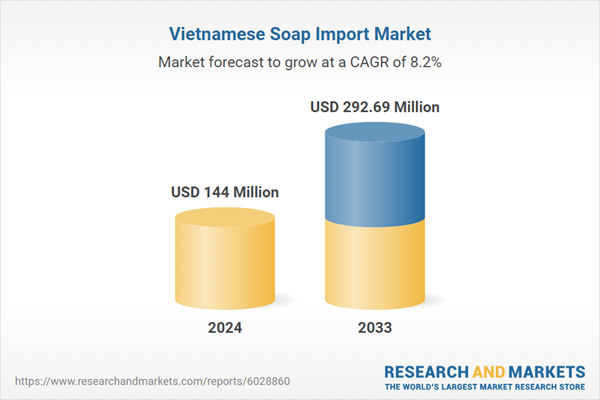Soap products come in diverse categories, covering various organic surfactants and their formulations. Typically, soap is produced in solid forms, such as bars, blocks, sheets, or molded pieces, but it also comes in liquid forms. As a household chemical product, soap is used not only for personal and laundry cleaning but also extensively in industrial cleaning, offering functions like washing, degreasing, sanitizing, and skincare. Specialized types include disinfectant soap, medicinal soap, and bleaching soap.
In recent years, Vietnam's soap market has expanded rapidly due to improving living standards and rising per capita income. Trends in the soap market show an increasing demand for natural, organic, functional, and handcrafted soaps. As a staple consumer product, soap has high and stable demand in Vietnam, with steady growth in market size.
In industrial fields, soap is used to clean, disinfect, and maintain industrial equipment, ensuring a safe and clean production environment. Industries like metal processing, machinery manufacturing, automotive maintenance, textiles, and leather processing widely use soap to remove oils and impurities from workpieces and materials. In the chemical sector, soap often acts as a thickener, lubricant, emulsifier, or catalytic ingredient.
Soap's upstream industries primarily include chemical raw material suppliers for fatty acids, glycerin, surfactants, plant extracts, fragrances, and colorants. Its downstream industries cover manufacturing, retail, e-commerce, and beauty and personal care. Leading global soap producers and exporters include Procter & Gamble (P&G), Unilever, L'Oréal, and Kao.
Vietnam's limited domestic soap production capacity makes it partly reliant on imports to meet market demand. According to the publisher's data, Vietnam imported approximately USD 120 million worth of soap in 2023. In the first half of 2024, soap imports reached USD 67 million, marking a nearly 20% increase from the same period in 2023.
The publisher analyzes that Vietnam's primary soap import sources from 2021-2024 included South Korea, Japan, and Singapore, with major suppliers like GALDERMA S.A., PT Unilever Oleochemical Indonesia, and Johnson & Johnson Consumer Asia Pacific Supply Chain Centre. Key soap importers in Vietnam are companies in beauty, personal care, and household goods sectors, primarily foreign-invested firms, including DKSH Vietnam Co., L'Oréal Vietnam Co., and Galderma Vietnam Co.
With economic growth, rising income levels, expanding consumer markets, and manufacturing development, Vietnam's soap market shows significant growth potential. The publisher forecasts that soap imports to Vietnam will continue increasing in the coming years as demand rises in both personal and industrial applications.
Topics covered:
- The Import and Export of Soap in Vietnam (2021-2024)
- Total Import Volume and Percentage Change of Soap in Vietnam (2021-2024)
- Total Import Value and Percentage Change of Soap in Vietnam (2021-2024)
- Total Import Volume and Percentage Change of Soap in Vietnam (2024)
- Total Import Value and Percentage Change of Soap in Vietnam (2024)
- Average Import Price of Soap in Vietnam (2021-2024)
- Top 10 Sources of Soap Imports in Vietnam and Their Supply Volume
- Top 10 Suppliers in the Import Market of Soap in Vietnam and Their Supply Volume
- Top 10 Importers of Soap in Vietnam and Their Import Volume
- How to Find Distributors and End Users of Soap in Vietnam
- How Foreign Enterprises Enter the Soap Market of Vietnam
- Forecast for the Import of Soap in Vietnam (2024-2033)
Table of Contents
Companies Mentioned
- GALDERMA S.A.
- PT UNILEVER OLEOCHEMICAL INDONESIA
- JOHNSON & JOHNSON CONSUMER ASIA PACIFIC SUPPLY CHAIN CENTRE
- DKSH VIETNAM CO.
- L’ORÉAL VIETNAM CO.
- GALDERMA VIETNAM CO.
Methodology
Background research defines the range of products and industries, which proposes the key points of the research. Proper classification will help clients understand the industry and products in the report.
Secondhand material research is a necessary way to push the project into fast progress. The analyst always chooses the data source carefully. Most secondhand data they quote is sourced from an authority in a specific industry or public data source from governments, industrial associations, etc. For some new or niche fields, they also "double-check" data sources and logics before they show them to clients.
Primary research is the key to solve questions, which largely influence the research outputs. The analyst may use methods like mathematics, logical reasoning, scenario thinking, to confirm key data and make the data credible.
The data model is an important analysis method. Calculating through data models with different factors weights can guarantee the outputs objective.
The analyst optimizes the following methods and steps in executing research projects and also forms many special information gathering and processing methods.
1. Analyze the life cycle of the industry to understand the development phase and space.
2. Grasp the key indexes evaluating the market to position clients in the market and formulate development plans
3. Economic, political, social and cultural factors
4. Competitors like a mirror that reflects the overall market and also market differences.
5. Inside and outside the industry, upstream and downstream of the industry chain, show inner competitions
6. Proper estimation of the future is good guidance for strategic planning.

LOADING...
Table Information
| Report Attribute | Details |
|---|---|
| No. of Pages | 80 |
| Published | November 2024 |
| Forecast Period | 2024 - 2033 |
| Estimated Market Value ( USD | $ 144 Million |
| Forecasted Market Value ( USD | $ 292.69 Million |
| Compound Annual Growth Rate | 8.2% |
| Regions Covered | Vietnam |
| No. of Companies Mentioned | 6 |









